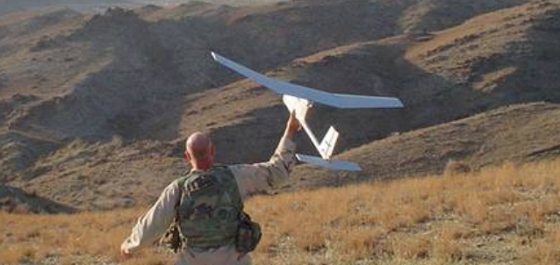|
|
|
A RQ-11A Raven UAV. US Army photo via Designation-Systems.Net. |
Yesterday, the Wall Street Journal published a report about Ugandan president Yoweri Museveni that contained a fallacious claim about the drones the US recently announced it is providing to Uganda and Burundi. The article, by Ioannis Gatsiounis, claims: “Washington has trained and equipped Mr. Museveni’s forces, with the latest boost coming last month in the form of a $50 million military consignment that included drones, surveillance systems and body armor. One of the drones was used in an airstrike on June 30 that wounded two top al Shabaab commanders. This led to at least 12 al Shabaab defections and widespread fear among remaining fighters, according to defectors.” In other words, the article contends that the US gave drones to Museveni and those drones were subsequently used in a strike that injured two Shabaab commanders. There are three major problems with this claim.
First, the drones that the US gave to Uganda were in fact unarmed. As Tara Vassefi and I pointed out on July 1, the drones given to Uganda are AeroVironment RQ-11 Raven miniature unmanned aerial vehicles. These unarmed UAVs weigh about 4.2 pounds, have a range capability of 4.9 to 7.45 miles, and can stay airborne for only about 60 to 90 minutes. You can get a sense of the RQ-11’s tiny size by looking at the photos here (the most telling of these graphics appears at the top of this entry).
In my earlier analysis of these drones, I pointed out how the reporting on this matter had become increasingly sloppy over time. Early reports made a big deal of the US providing drones, and juxtaposed this news with reports of airstrikes, thus implying that the drones were armed. However, an early Associated Press report did describe them as “small, shoulder-launched Raven drones,” while subsequent reporting from the BBC neglected to even mention their small size.
The second problem is that Gatsiounis’s article has no source for its claim that a Ugandan drone struck the Shabaab commanders. In fact, his report illustrates precisely why the early sloppy reporting is so dangerous. Most likely, Gatsiounis simply saw reports of the US providing drones to Uganda, saw that there was an airstrike in Somalia, and mentally connected the two. But obviously the fact that the US had just given Uganda drones does not mean that a subsequent drone strike in Somalia was carried out with those drones. (The airstrike was almost certainly a US strike, not a Ugandan strike.)
And the third problem is that the airstrike did not occur on June 30, as Gatsiounis claimed. Instead, it came on June 25 but was reported later (it was reported on June 29, not June 30). Lest someone think there were in fact two drone strikes, this report about the June 25 strike makes clear that Gatsiounis in fact has that strike in mind. The details are identical to what he claimed occurred on June 30, with two senior Shabaab commanders being targeted. The linked report also makes clear that they were targeted by Predators and not Ravens, which is why specifying the military hardware being used is so vital to avoiding error.
As someone who writes about Somalia frequently, I find the often low-quality reporting and mistaken claims made about the country to be frustrating, in no small part because they frequently get recirculated by subsequent writers. It is, I suppose, not altogether unreasonable to trust a factual claim because it appeared in the Wall Street Journal. But the fact that this erroneous claim did appear in the Wall Street Journal shows precisely why those who want to be conversant about Somalia should double- and triple-check their facts before writing on it. And it also shows that even the Wall Street Journal needs to be far more conscientious about what it publishes.
Update, 9:30 p.m.: Yup, this is the drone that the Wall Street Journal thinks is out waxing senior Shabaab commanders. (Hat tip: Lauren Jenkins.)
Are you a dedicated reader of FDD's Long War Journal? Has our research benefitted you or your team over the years? Support our independent reporting and analysis today by considering a one-time or monthly donation. Thanks for reading! You can make a tax-deductible donation here.









5 Comments
Nice to see you so fired up over these “small,” apparently insignificant drones. Your broader point about reporting on Somalia is well taken, and applies to so many hot spots in the developing world… especially in the mainstream media.
“One of the drones was used in an airstrike on June 30 that wounded two top al Shabaab commanders. ”
The drone, by this language, may have been used to pinpoint and validate the target with a helicopter or other aircraft called in to strike. Your argument does not refute this possibility.
Neil:
The strike occurred in Kismayo. Uganda has no troops in Kismayo, only in Mogadishu. The RQ-11 Ravens have a range capability of 4.9 to 7.45 miles, which doesn’t even cover greater Mogadishu, and they can only stay airborne for 60-90 minutes.
Some quick math on this will surely reveal that the drones the U.S. gave to Uganda weren’t used to validate targets in Kismayo either.
Dear David,
I totally agree with you about the low-quality reporting and mistakes about Somali issues. About the 25th of June raid, is the same AP claimed to have been followed by an US mission on the ground? (http://news.yahoo.com/somalia-us-took-bodies-militants-strike-142138601.html)
Great choice of photo David. Misinformation debunked in a single picture.